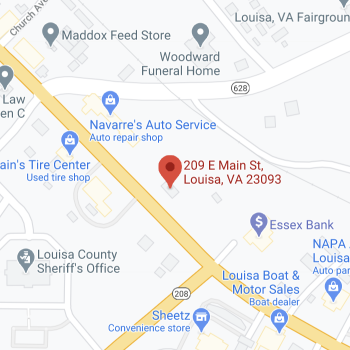Henrico County, Virginia
Henrico County (formerly Henrico Shire) /hɛnˈraɪkoʊ/, officially the County of Henrico, is a county in the Commonwealth of Virginia in the United States. As of the 2010 census, the population was 306,935.[4] In 2018, the population was estimated to be 329,261,[3] making it the fifth-most populous county in Virginia and the sixth-most populous county-equivalent in Virginia. Henrico County is included in the Greater Richmond Region. There is no incorporated community within Henrico County, therefore, there is no incorporated county seat either. Laurel, an unincorporated CDP, serves this function.
Named after the Citie of Henricus, Henrico was organized in 1634 as one of the eight original Shires of Virginia.
It is one of the United States’ oldest counties. The City of Richmond was officially part of Henrico County until 1842, when it became a fully independent city.[5]
The present-day Henrico County curves around the City of Richmond, surrounding it to the west, the north, and the east. The county is bounded by the Chickahominy River to the north and the James River and Richmond to the south.[6]
Richmond Raceway is in the central portion of Henrico County near Mechanicsville, just north of the Richmond city limits. The raceway seats approximately 60,000 people and holds two NASCAR doubleheader race weekends per year.[7] Additionally, Richmond International Airport is located in the eastern portion of Henrico County in Sandston. Top private employers in the county include Capital One, Bon Secours Richmond Health System, and Anthem.[8]
History[edit]
In 1611, Thomas Dale founded the Citie of Henricus on a peninsula in the James River that is now called Farrar’s Island.[9] Henricus was named for Henry Frederick, Prince of Wales, but it was destroyed during the Indian massacre of 1622, during which local Native American warriors of the Powhatan confederacy attacked the English settlers to drive them from the area.[10]
In 1634, Henrico Shire was one of the eight original Shires of Virginia established in the Virginia Colony.
Since then, 10 counties and three independent cities have been formed from the original territory of Henrico Shire.[5]
Since becoming independent in 1842, the City of Richmond has successfully annexed portions of Henrico five times.[11] Chesterfield County annexed the site of Henricus in 1922.[5]
Richmond attempted to completely merge with Henrico in 1961, but 61% of the votes in a referendum in Henrico county voted against the merger.[12] In 1965, Richmond attempted to annex 145 square miles of Henrico County. However, after a lengthy court battle, the city was given permission to annex only 17 square miles. Since the city would have had to reimburse Henrico a hefty $55 million, Richmond opted against annexing the 17 square miles.[2][12]
In 1981, the Virginia General Assembly placed a moratorium on all annexations throughout the state.[13] Henrico’s borders have not changed since Richmond’s 1942 annexation.
County seat[edit]
The original county seat was at Varina, at the Varina Farms plantation across the James River from Henricus. Colonist John Rolfe built this plantation, where he lived with his wife, Pocahontas.[14] Henrico’s government was located at Varina from around 1640 until 1752.[2]
In 1752, Henrico relocated its seat to a more central location inside the city of Richmond, between Church Hill and what is now Tobacco Row. The county seat remained at 22nd and Main St in Richmond even after the city’s government became fully independent of the county in 1842.[5] It was not until 1974 when the county moved out of the Henrico County Courthouse to a complex in the western portion of the county at the intersection of Parham Road and Hungary Springs Road in Laurel.[2]
In addition to the 1974 complex, in 1988 the county opened its Eastern Government Center to be more convenient to county residents in the eastern portion of the county. It is located on Nine Mile Road.[2]
American Civil War battle sites[edit]

Cannons at the site of the Battle of Malvern Hill
During the Civil War, in 1862 Henrico County was the site of numerous battles during the Peninsula Campaign, including:
- Battle of Seven Pines,
- Battle of Savage’s Station,
- Battle of Oak Grove,
- Battle of Garnett’s & Golding’s Farm,
- Battle of White Oak Swamp,
- Battle of Glendale, and
- Battle of Malvern Hill.
Additional significant battles took place in 1864 during the Overland Campaign prior to and during the Siege of Petersburg, which led to the fall of Richmond. Confederate General J.E.B. Stuart was mortally wounded in Henrico County at the Battle of Yellow Tavern on May 12, 1864.
Transportation[edit]
Henrico County is one of only two counties in Virginia that maintains its own roads, with the other being Arlington County. This special status was due to the existence of county highway departments prior to the creation in 1927 of the state agency that is now VDOT; and the assumption by that agency in 1932 of local roads in most counties. (Henrico and Arlington were grandfathered and allowed to continue pre-existing arrangements.) The control of the roads system is considered a powerful advantage for community urban planners, who can require developers to contribute to funding needed for road needs serving the planners’ and developers’ projects.
Henrico County is the site of Richmond International Airport. It hosts an Amtrak rail passenger station. It purchases public bus route services from Greater Richmond Transit Company, an FTA-funded public service company that is owned equally by the City of Richmond and neighboring Chesterfield County.
After Reconstruction, Henrico County used Convict lease to build roads in 1878.[15]
Some old roads continue to be in use today, such as Horsepen Rd., Three Chopt Rd., and Quiocassin Rd
.









